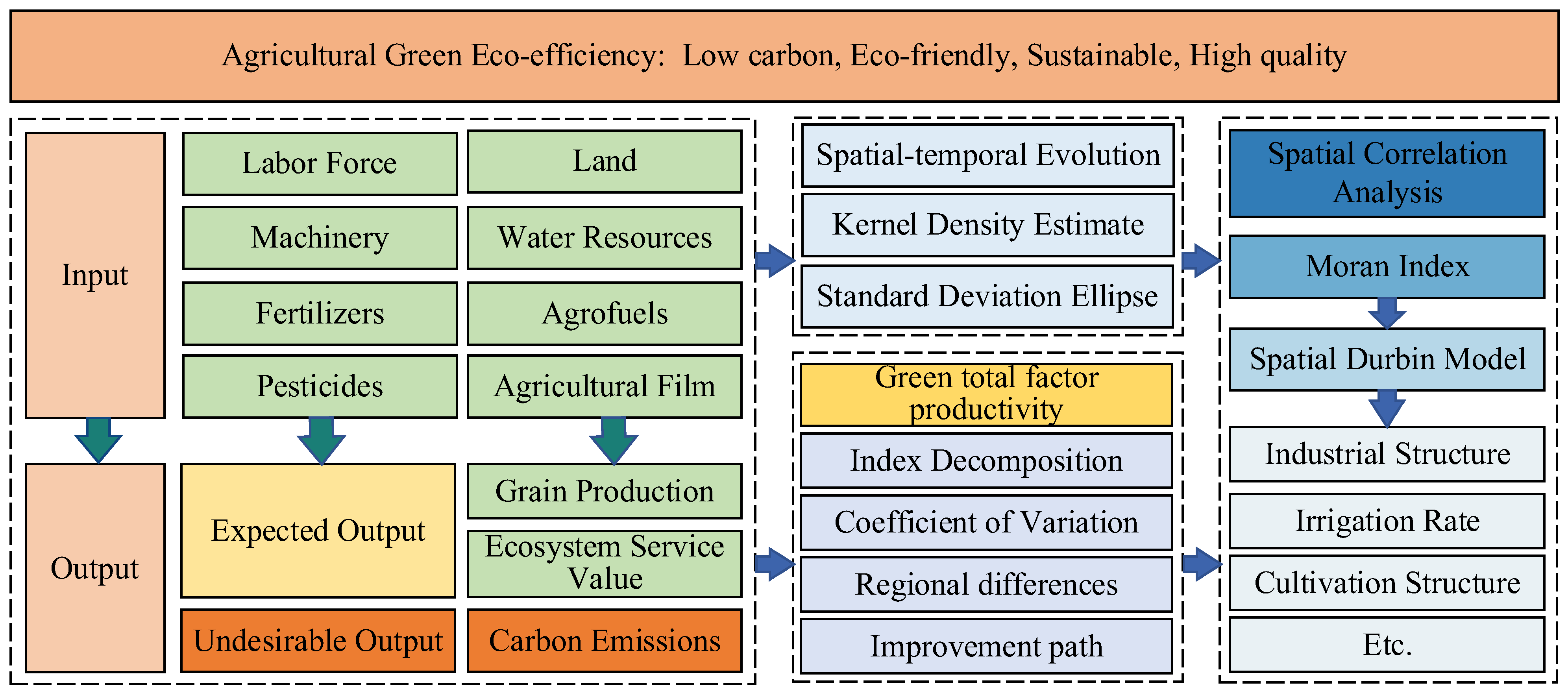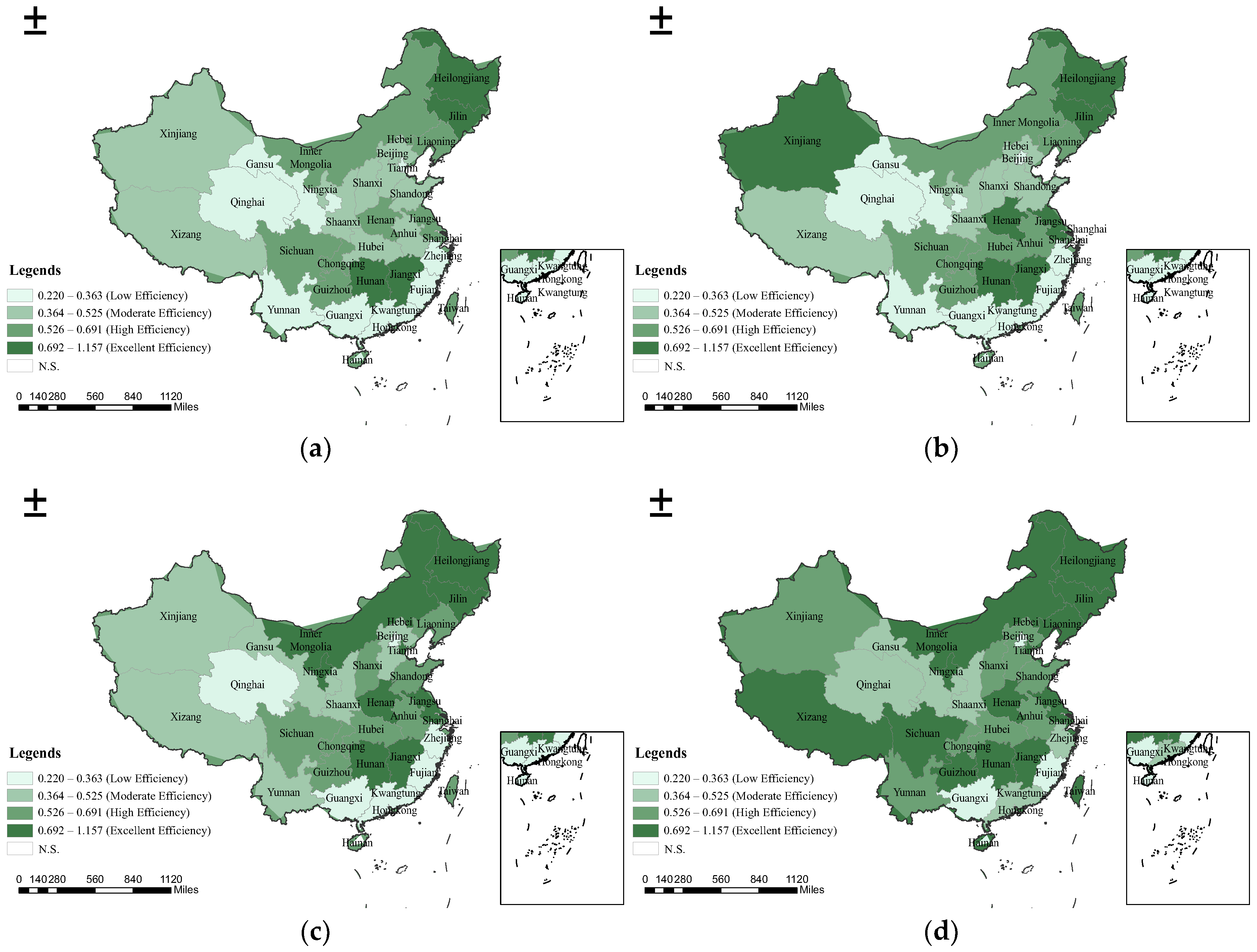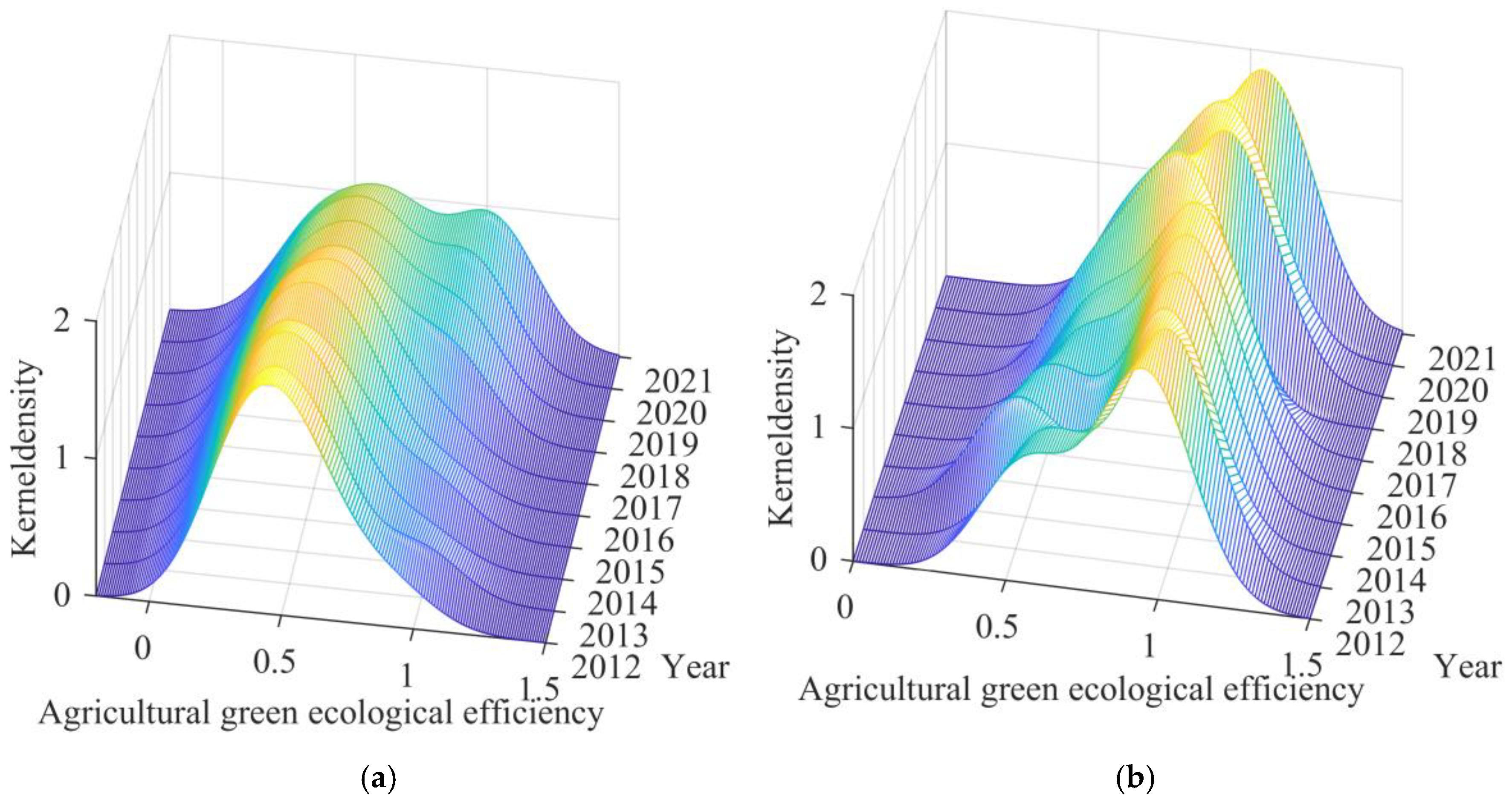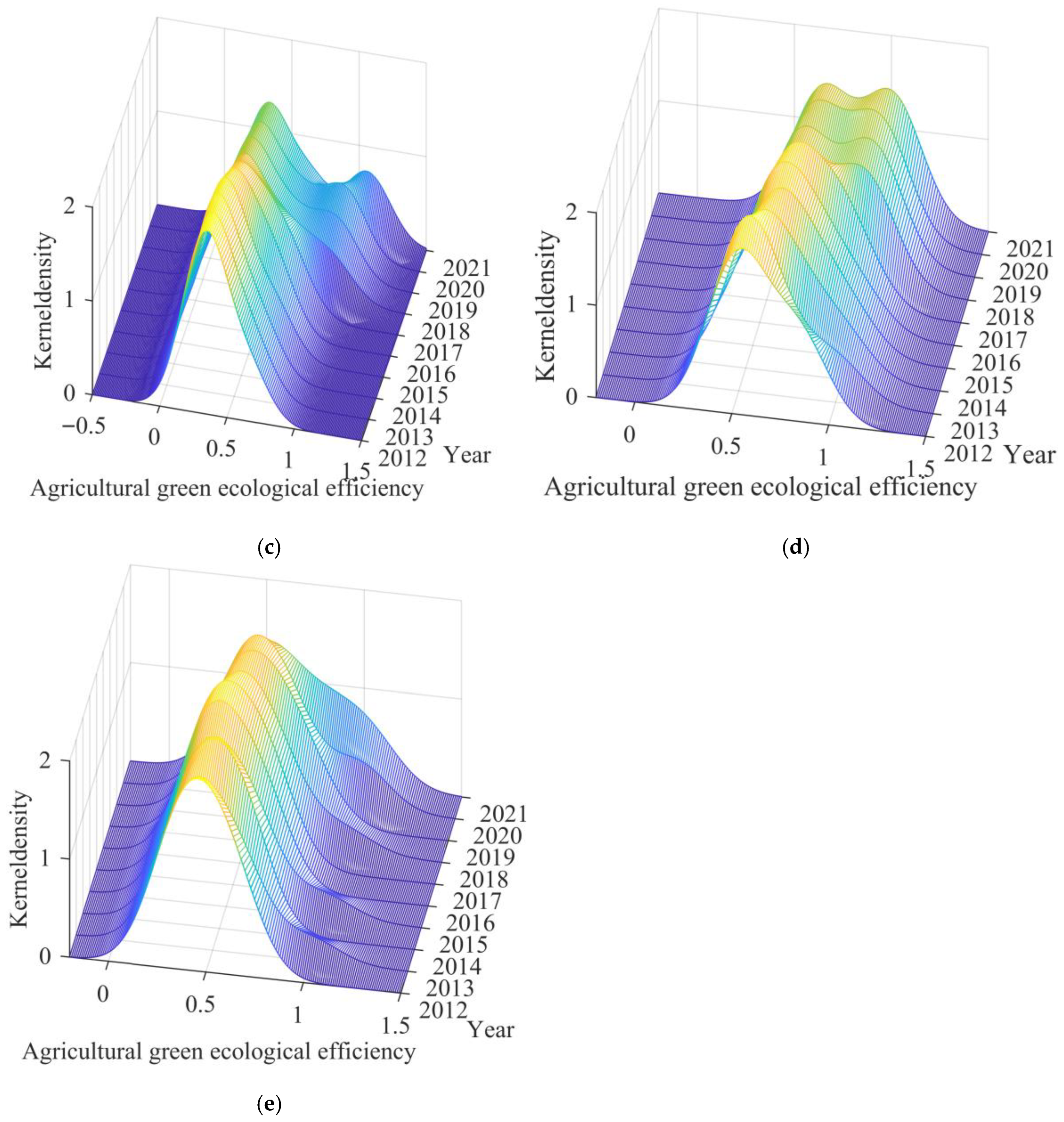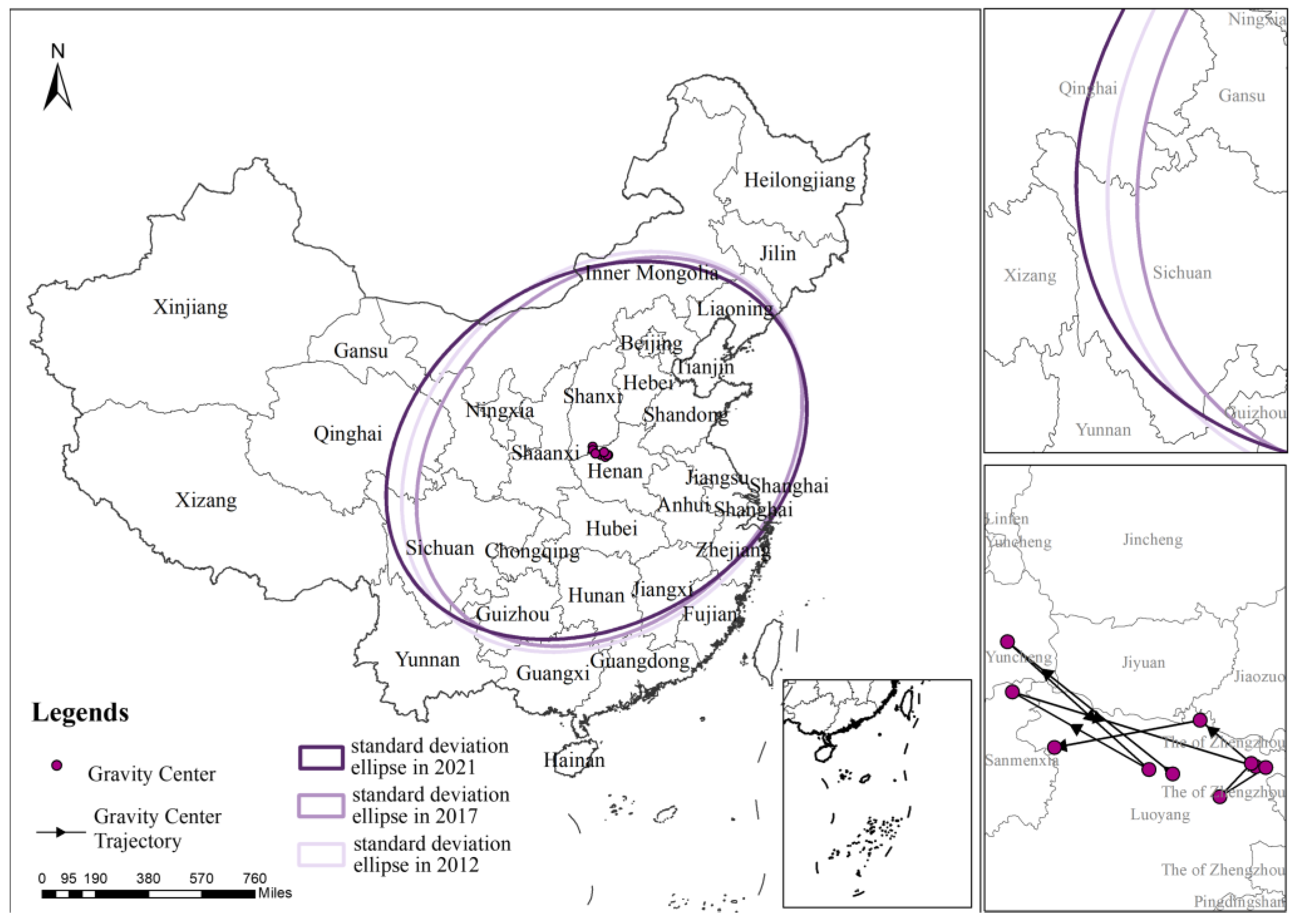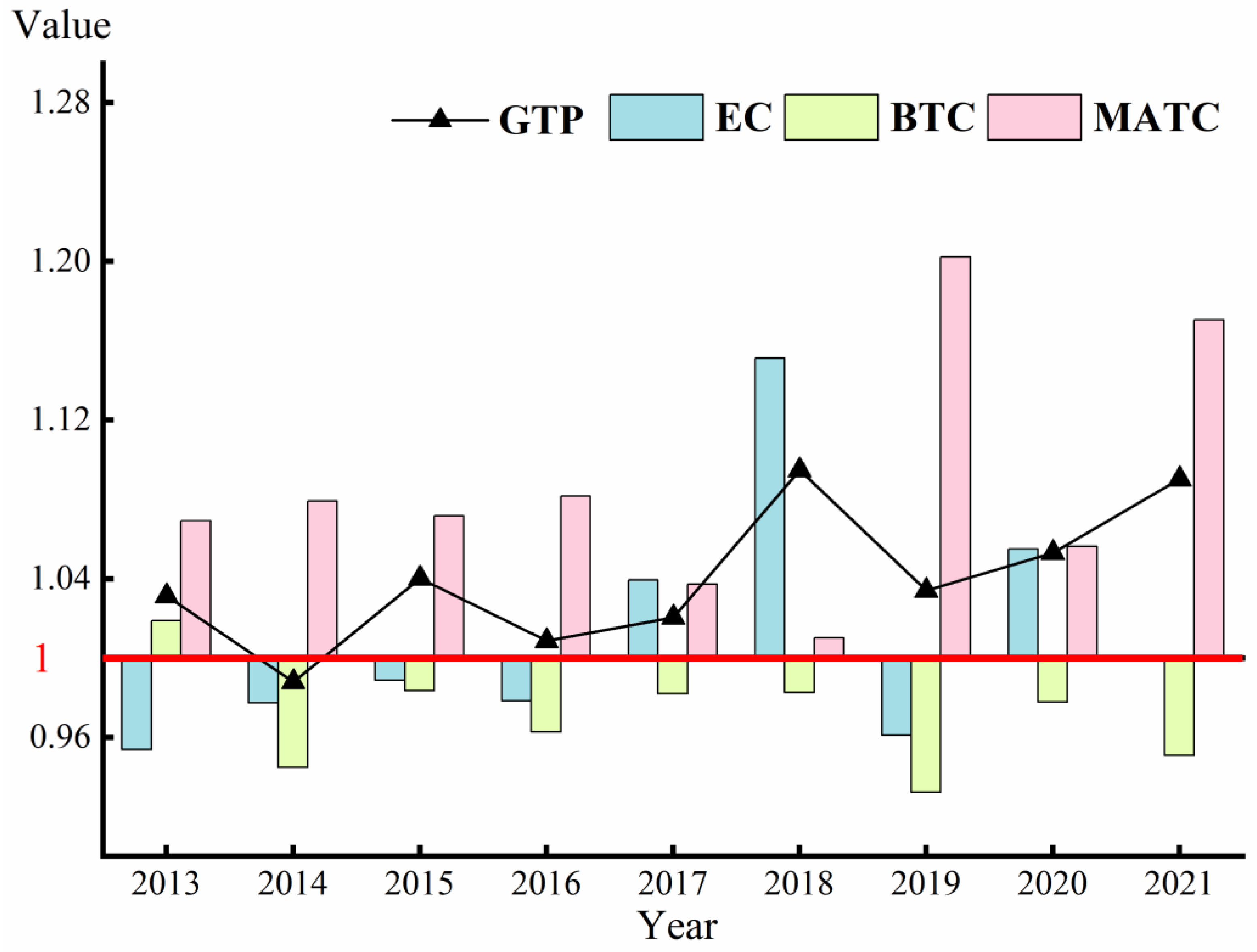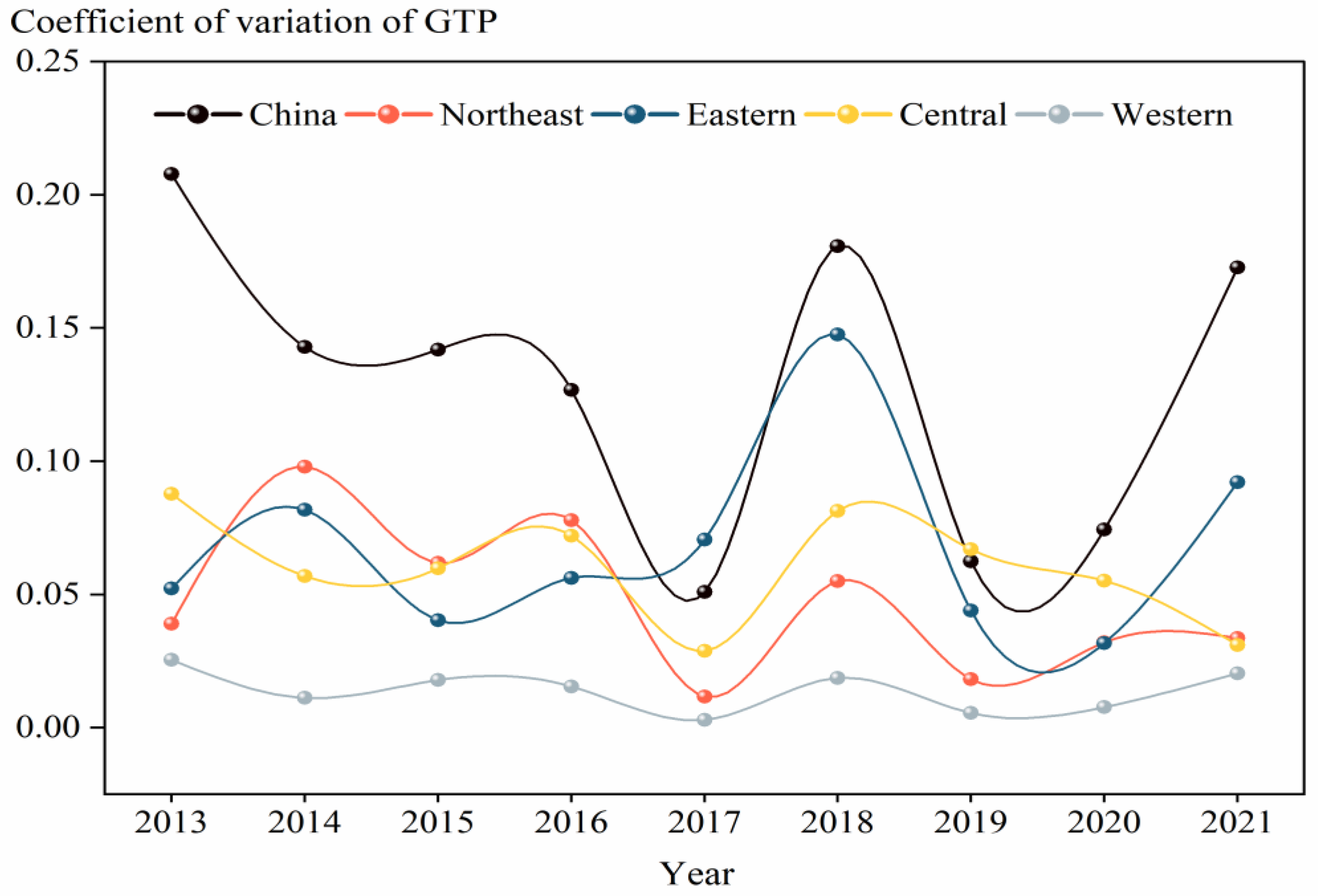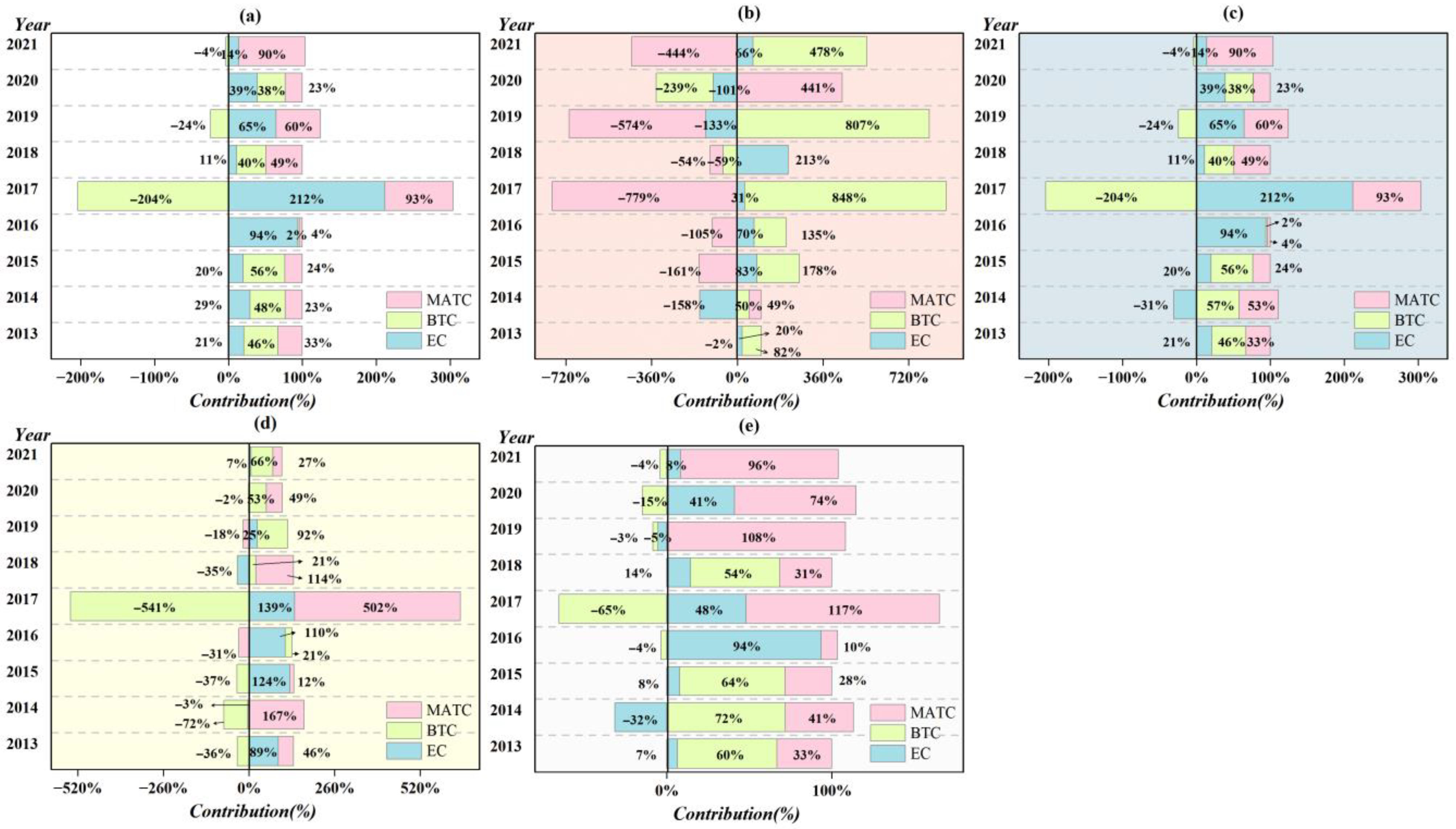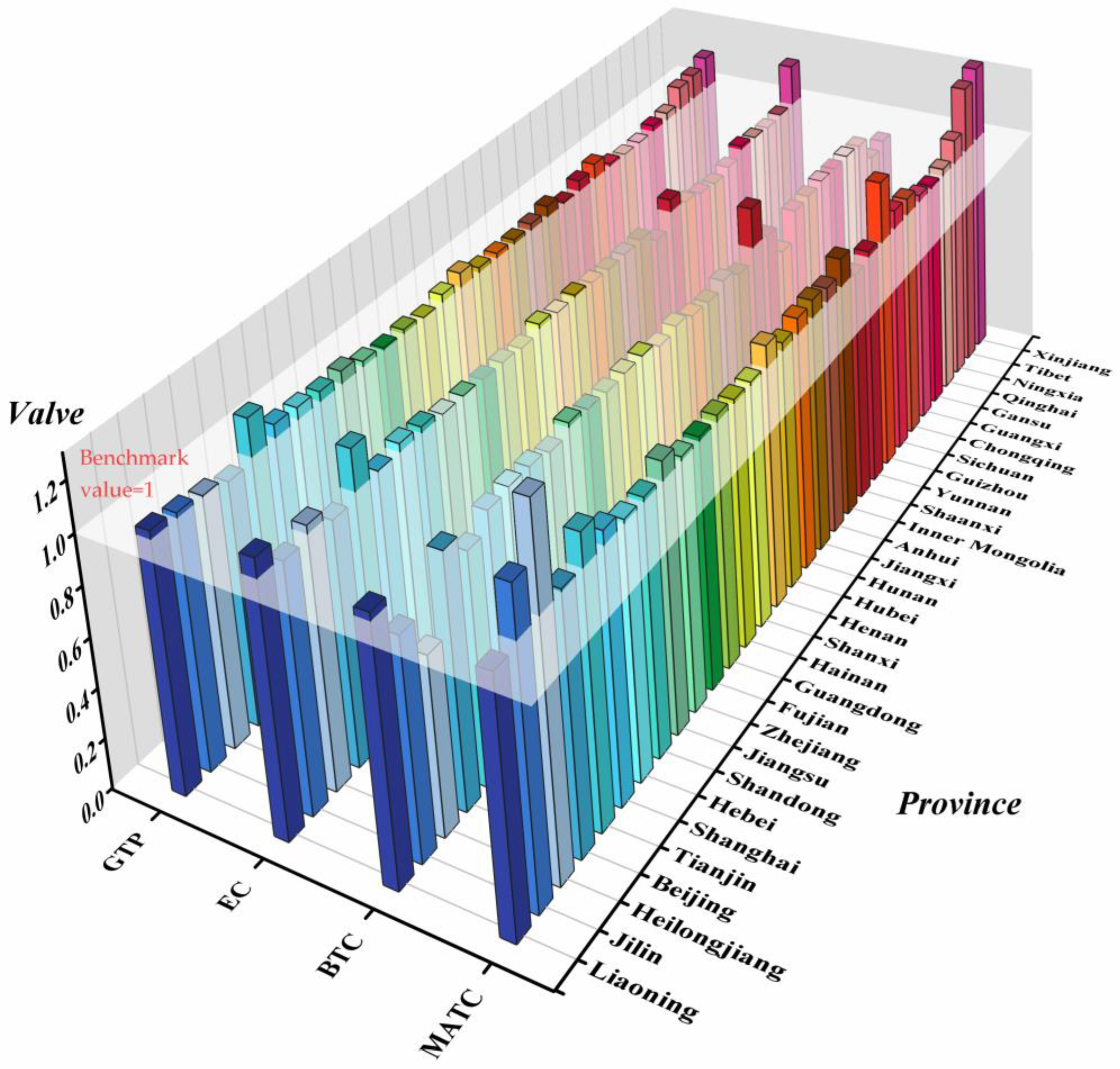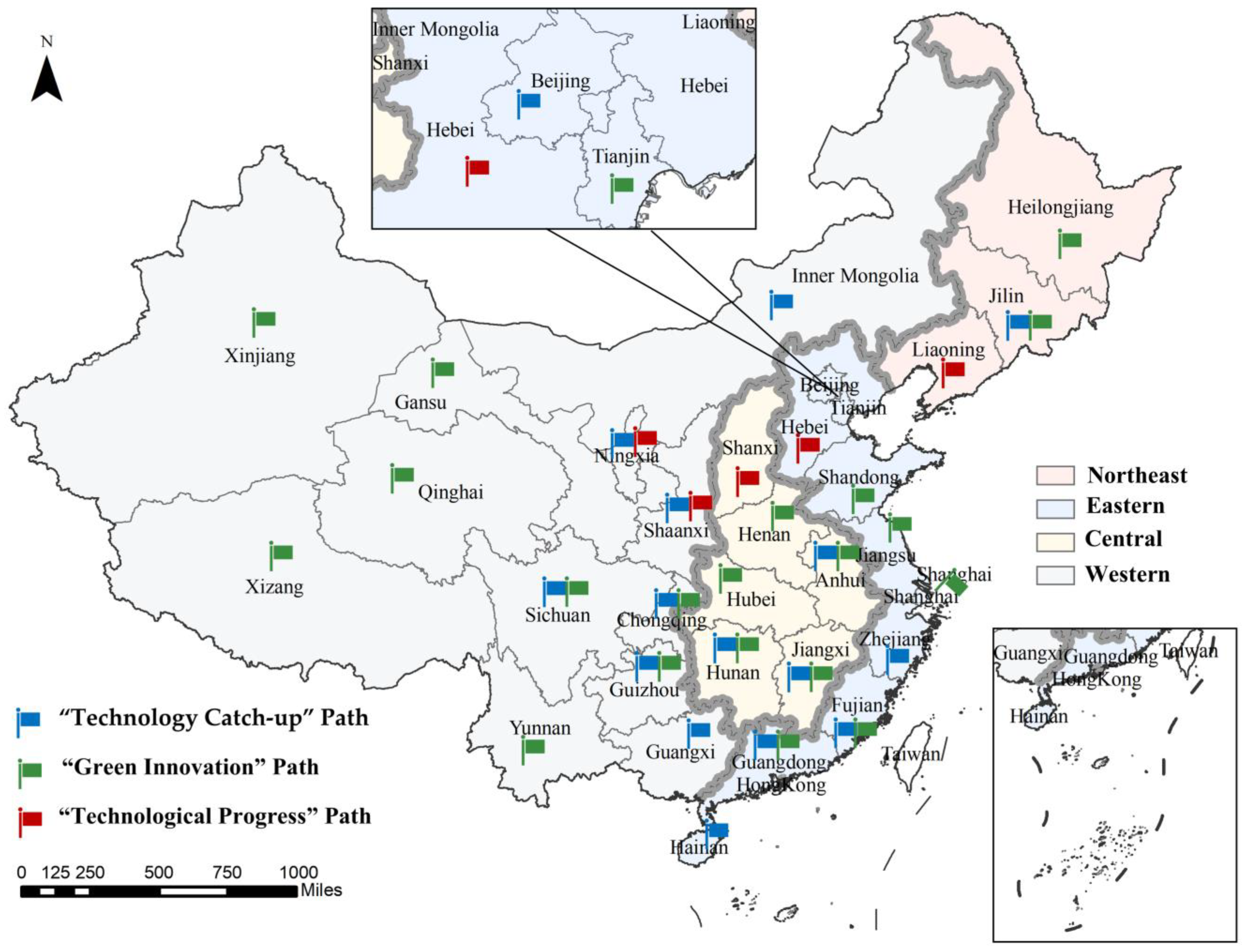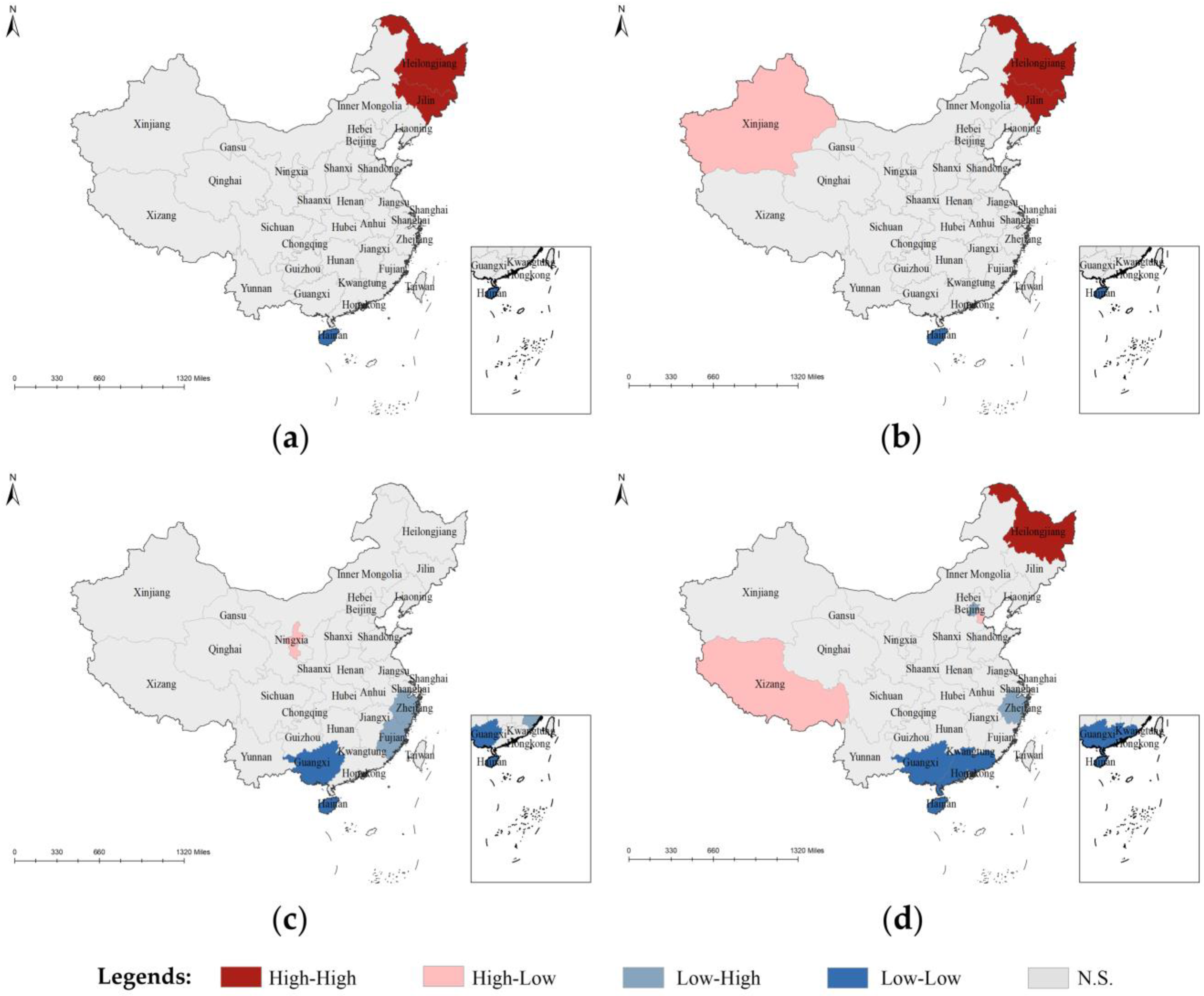1. Introduction
Agriculture, as a foundational industry of China’s socio-economic system, has consistently been integrated into the core of the national strategic agenda and has achieved remarkable progress [
1,
2,
3,
4]. Amid the intensifying global food crisis, China sustained two decades of grain production growth, reaching a new record of 707 million tons in 2024. With a per capita grain availability of 501.8 kg, which is considerably higher than the 400-kg threshold commonly used to assess food security, China maintains a strong position in ensuring national food supply [
5]. Nevertheless, frequent international conflicts have severely disrupted global food supply chains, while accelerated urbanisation, combined with demographic ageing, has fuelled a persistent and increasingly inflexible rise in food demand [
6,
7]. Under such circumstances, ensuring food security remains the primary task in China’s agricultural development in the foreseeable future [
8]. Meanwhile, China’s agricultural development is increasingly constrained by resource and environmental limitations. The country must support nearly 18% of the global population despite its severely limited land and water endowments—having less than 40% of the global average per capita arable land and only one-quarter of the per capita water resources [
9,
10,
11]. Over the past few decades, the intensive agricultural model, characterised by excessive resource inputs and environmental burdens, has exacerbated the depletion of arable land and water supplies, while significantly increasing greenhouse gas emissions and intensifying diffuse agricultural pollution [
12]. Against this backdrop, China’s agricultural sector must adopt sustainable development principles, aiming to satisfy rising food demands while safeguarding the ecological foundations critical to long-term agricultural viability [
13,
14].
Agricultural green ecological efficiency (AGEE) has emerged as a key metric for evaluating regional progress toward sustainable agriculture, drawing increasing attention from both policymakers and scholars [
15,
16]. AGEE is generally defined as the capacity to maximise desirable agricultural outputs while minimising resource consumption and ecological degradation, reflecting the synergy between economic development and ecological protection in agricultural production [
17]. Among the various environmental issues arising from agricultural production, agricultural carbon emissions hold a particularly high strategic priority. This is not only due to agriculture’s substantial contribution to global carbon emissions (accounting for 17%) [
18,
19], but also stems from the explicit emission reduction requirements imposed by the Chinese government’s “dual carbon” goals [
20,
21]. Meanwhile, agricultural output encompasses not only the direct economic value of farm products but also the often-overlooked ecosystem services value (ESV) [
22,
23]. Agricultural ecosystem services include gas regulation [
24], pollination facilitation [
25], biodiversity increase [
26], social relationship enhancement [
27], and the provision of aesthetic landscapes—representing diverse natural benefits humans derive from agroecosystems. However, prior AGEE assessments have largely emphasised carbon emissions and economic value while giving limited consideration to ESV, which may bias efficiency estimates away from the actual state of sustainable agricultural development [
28,
29,
30]. Accordingly, to capture both the positive and negative ecological externalities embedded in China’s agricultural production, we incorporate carbon emissions and ESV simultaneously into the AGEE accounting framework. The Malmquist Index (MI) provides a powerful tool for quantifying the dynamic changes in AGEE and disentangling the specific contributions of technological factors [
31]. Moreover, given China’s vast territory and significant disparities in natural endowments and development conditions across regions, progress in AGEE has been uneven. At the national level, narrowing interregional gaps in AGEE advancement and promoting equity are essential safeguards for sustainable green agricultural development; at the provincial level, place-based strategies are needed to design differentiated improvement paths aligned with each region’s AGEE profile. However, in the agricultural sector, few studies have integrated the MI with regional heterogeneity to assess the convergence trends of AGEE growth, analyze the mechanisms behind such convergence, or identify province-specific improvement paths. This gap is particularly consequential for policy design: understanding whether AGEE is rising and the sources of that growth can anchor policies that promote green, sustainable agriculture, while analyzing regional convergence and divergent development paths across provinces can improve resource allocation and advance balanced regional development.
Beyond intrinsic technical factors, AGEE is also shaped by exogenous factors. Existing studies have identified the roles of socio-economic variables, such as population ageing, per capita GDP, and urbanisation [
32,
33,
34]. However, they often overlook the spatial effects arising from geographical linkages. Due to geographical proximity, similarities in resource endowments, and policy imitation, AGEE may exhibit spatial autocorrelation. Furthermore, with the increasing frequency of cross-regional flows of production factors and technology spillovers, it is imperative to introduce a spatial dimension when examining factors influencing AGEE. Based on the above analysis, we propose the following research questions: Within a framework that simultaneously accounts for carbon emissions and ESV, what spatiotemporal patterns does AGEE exhibit? Has AGEE achieved sustained growth, and which technological components drive that growth? Given pronounced regional disparities, does AGEE growth display convergence—and through what mechanisms? How should provinces select suitable improvement paths? Moreover, as regional interactions intensify, do the factors influencing AGEE display spatial interdependence?
In response to these questions, this study first integrated carbon emissions and ESV to account for AGEE in China, employing kernel density estimation and the standard-deviation ellipse (SDE) to identify its spatiotemporal evolution. Secondly, the Malmquist index was used to compute the green total factor productivity (GTP) as a quantitative indicator of AGEE dynamics, examining the specific contributions of three technological components: MATC, BTC, and EC. Subsequently, the coefficient of variation and variance decomposition were applied to reveal the convergence trends and mechanisms underlying the AGEE dynamics. Finally, the spatial Durbin model was utilised to analyse the AGEE’s influencing factors and their associated spatial spillover effects.
This study makes three contributions. First, by integrating both the positive and negative ecological externalities of agriculture, we develop an AGEE accounting framework that combines ESV and carbon emissions, providing a more comprehensive—and policy-relevant—basis for subsequent efficiency assessments. Second, we use the Malmquist index and its decomposition to elucidate the drivers and regional heterogeneity of AGEE growth, thereby identifying province-level, differentiated improvement paths for tailored policy design. Third, we introduce spatial econometric methods to examine the spatial spillovers of factors influencing AGEE, advancing our understanding of interregional linkages and coordinated development mechanisms, and offering a theoretical basis for cross-regional agri-environmental governance. The research framework is shown in
Figure 1.
2. Literature Review
The concept of eco-efficiency first emerged in the 1990s, aiming to maximise the fulfilment of human needs while minimising resource consumption and environmental pollution [
35,
36]. With the advancement of the global sustainable development agenda, this concept has been widely applied to urban systems [
37,
38], the energy sector [
39,
40], manufacturing [
41], and many other fields and has gradually been extended to agriculture. Agricultural Green Ecological Efficiency (AGEE) refers to achieving the greatest possible agricultural output with limited resource inputs while minimising environmental pollution [
30]. Internationally, similar concepts include Sustainable Intensification in Agriculture [
42], green agricultural productivity [
43], agricultural carbon efficiency [
44], and Agricultural Green Development Efficiency [
45], among others. Current academic research primarily focuses on three aspects: the accounting of AGEE, its multi-perspective assessment, and the analysis of influencing factors.
2.1. AGEE Accounting Model
Methods for accounting agricultural eco-efficiency include the life-cycle approach [
46], ecological footprint analysis [
47], ratio methods [
48], and stochastic frontier analysis [
49]. Compared to these methods, nonparametric methods, such as data envelopment analysis (DEA), offer clear advantages in handling multi-input, multi-output systems without prespecifying a production function—an especially relevant feature for agricultural systems, characterised by diverse resource structures and output types [
30]. However, traditional DEA models fail to incorporate undesirable outputs, thus inaccurately reflecting efficiency losses due to environmental pollution and leading to biased eco-efficiency accounting. To address this issue, Tone (2002) [
50] proposed the super-efficiency slack-based measure (Super-SBM) model that explicitly accommodates undesirable outputs. This model captures both desirable and undesirable outputs and allows further discrimination among efficient decision-making units, thereby improving precision and separability. This approach has been widely applied to agricultural eco-efficiency studies [
30,
44]. Following the mainstream, this study adopts the Super-SBM to construct a composite AGEE accounting measure.
Regarding indicator selection, based on insights into agricultural system inputs and outputs, existing studies have reached a relatively high consensus on input indicators, typically including labour, land, machinery, irrigation water, and pesticide use [
51,
52,
53]. For output indicators, studies have emphasised economic outcomes and environmental impacts. For example, Chi et al. (2022) [
54] and Ge et al. (2023) [
45] selected agricultural value added as a desirable output and carbon emissions as an undesirable output, respectively. Yu and Wei (2025) [
55] further incorporated crop yield and diffuse agricultural pollution to evaluate cultivated land-use efficiency. However, these studies often overlook the ecosystem service value (ESV)—the direct benefits agroecosystems provide to humans. Although balancing economic and ecological value has become a global consensus for sustainable agriculture [
17,
56], incorporating ESV into AGEE accounting remains limited [
28,
29,
30]. In practice, continued exploitation of agricultural resources can constrain the realisation of ESV [
57]; ignoring ESV as part of desirable outputs may therefore bias AGEE accounting away from the actual state of sustainable development. Accordingly, within the Super-SBM framework, we develop an AGEE indicator system that simultaneously integrates ESV and carbon emissions. Compared to prior work, this accounting framework better captures agriculture’s multifunctionality, avoids one-sided underestimation in regions of high ecological value, and provides a more rigorous and equitable basis for subsequent efficiency assessments.
2.2. Multi-Perspective Assessment of AGEE
Assessment based on efficiency accounting results can be broadly categorised into two perspectives: “growth” in the temporal dimension and “equity” in the spatial dimension. Temporally, numerous studies document the evolution of AGEE across countries and regions. For example, Wang et al. (2024) [
58] measured the agricultural energy efficiency of 144 countries across five continents from 2011 to 2021, finding a significant increase in all regions except Oceania. Liu et al. (2020) [
33] reported a 76% increase in provincial agricultural eco-efficiency in China over the past four decades. However, such time-trend descriptions based on cross-sectional snapshots yield only limited qualitative insights. The Malmquist index (MI) provides a stronger tool by offering a quantitative measure of efficiency growth and decomposing it into contributions from technical change (TC) and technical efficiency (TE). In agriculture, the MI approach has seen increasing use. For example, Yang et al. (2022) [
31] found that the growth rate of agricultural eco-efficiency across Chinese provinces from 2001 to 2018 was relatively low, with TC being the key driver; Chivu et al. (2020) [
59] likewise found productivity gains in U.S. agricultural cooperatives to be driven by TC rather than EC. A standard limitation in these studies is the default assumption of Hicks-neutral TC. In reality, technological progress in most regions and sectors is biased [
60]—whether it involves input-saving on the production side or is aimed at reducing undesirable outputs, such as CO
2, on the outcome side—reflecting a shift toward greener technologies [
61]. Disentangling the biased component within TC is therefore crucial for accurately identifying the underlying drivers of AGEE growth. In this vein, Liu et al. (2022) [
61] decomposed green TFP into technical efficiency (EC), biased technical change (BTC), and magnitude of technological change (MATC), and examined how environmental regulation affects manufacturing productivity and its components. Related applications to agriculture, however, remain scarce.
Spatially, pronounced regional imbalance in AGEE is widespread, particularly in developing countries and regions with intensive agriculture, owing to heterogeneity in development bases and natural endowments. Wang et al. (2024) [
58] emphasised the large and widening regional gaps in global agricultural energy efficiency. At the farm level in Africa, Gollin and Udry (2020) [
62] documented substantial productivity dispersion. Using the Dagum Gini decomposition, Jin et al. (2024) [
44] showed that within-region differences are the primary source of overall disparity in agricultural carbon efficiency across China’s three major grain-production zones. While these studies underscore the importance of spatial heterogeneity, most focus on static indicators. In fact, regional gaps in AGEE reflect the cumulative outcomes of divergent growth dynamics; examining convergence in AGEE growth can yield more fundamental insights for balanced regional development. Probing the mechanisms behind divergence is likewise essential for policies that enhance equity. The limited existing work that employs econometric models or GeoDetector highlights the role of resource inputs in shaping spatial disparities [
30,
44] but largely neglects technological factors as fundamental sources of these differences.
2.3. Factors Influencing AGEE
In recent years, a growing body of research has focused on various socio-economic factors affecting AGEE. Li et al. (2022) [
63] employed a PVAR model to analyse the long-run equilibrium among population ageing, renewable resource consumption, and agricultural green productivity, while Zhao et al. (2023) [
34] detailed the channels through which urbanisation—as a core driver—affects agricultural eco-efficiency. However, due to geographical proximity, similarities in resource endowments, and policy imitation behaviour, AGEE is likely to exhibit spatial autocorrelation. Moreover, the frequent interregional flow of production factors and technology spillovers between neighboring provinces may lead to cross-regional effects of various influencing factors. It is therefore necessary to incorporate geographic variables to broaden analyses of AGEE’s influencing factors.
Taken together, the existing literature still shows three salient gaps: (1) Indicator selection for AGEE accounting. Most studies focus solely on ecological negative externalities, treating carbon emissions and other pollutants as undesirable outputs, while overlooking the substantial benefits provided by ecosystems. This omission can bias AGEE accounting away from the actual state of sustainable agricultural development. (2) Limited understanding of AGEE dynamics. The conventional assumption of Hicks-neutral technological progress is not only unrealistic but also hinders the identification of the fundamental drivers behind AGEE growth. Furthermore, assessments of “growth” and “equity” are often conducted in isolation, failing to provide practical insights for achieving regionally coordinated AGEE development. (3) There is a lack of in-depth investigation into the spillover mechanisms of various exogenous factors affecting AGEE. To address these gaps, this study constructs a more comprehensive analytical framework for AGEE. It refines the sources of AGEE dynamics into MATC, BTC, and EC, examines both the regional equity of AGEE growth and its underlying causes, and thoroughly investigates the comprehensive impact of exogenous factors—including their spatial spillover effects. This study aims to provide a more comprehensive and detailed understanding of AGEE in China, thereby supporting the identification of effective strategies to promote the achievement of sustainable agricultural development goals.
